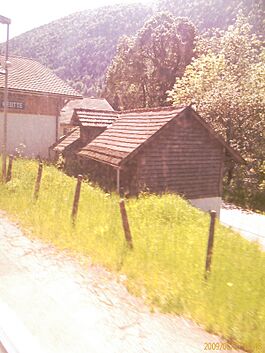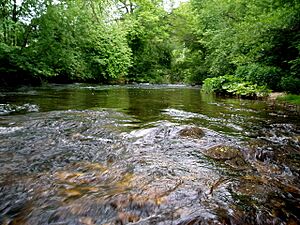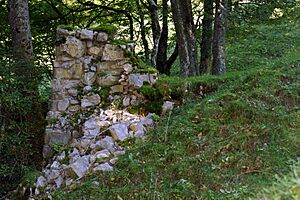La Heutte facts for kids
Quick facts for kids
La Heutte
|
||
|---|---|---|

La Heutte village train station
|
||
|
||
| Country | Switzerland | |
| Canton | Bern | |
| District | Jura bernois | |
| Area | ||
| • Total | 8.0 km2 (3.1 sq mi) | |
| Elevation | 615 m (2,018 ft) | |
| Population
(Dec 2013)
|
||
| • Total | 485 | |
| • Density | 60.6/km2 (157.0/sq mi) | |
| Postal code |
2604
|
|
| Surrounded by | Sonceboz-Sombeval, Orvin, Péry, Reconvilier, Tavannes | |
La Heutte was once a municipality in Switzerland. It was located in the French-speaking part of the canton of Bern, called the Bernese Jura.
On January 1, 2015, La Heutte joined with the nearby municipality of Péry. Together, they formed a new municipality called Péry-La Heutte.
Contents
History of La Heutte
La Heutte was first mentioned in old documents in 1393. Back then, it was known as Hütte. It got its current name, La Heutte, in 1727.
Early Settlements and Glassworks
Around 1370, there was a "glass-hut" or glass factory in the area. This factory was part of a fief (land given to someone in exchange for loyalty) owned by the d'Orsans family.
By 1393, a small village had grown up around this glass factory. The village was part of the seigniory (land ruled by a lord) of Erguel. This area was also part of the Diocese of Basel, which was a church district.
La Heutte was part of the parish (a church community) of Péry. In 1530, the city of Biel changed the entire Péry parish to the Protestant Reformation. This meant La Heutte also became Protestant.
During the 1700s, Biel tried to gain more power. This led to many disagreements with nearby villages, including La Heutte.
Growth and Industry
The first glass factory was located north of the village, at a place called Le Van. It existed even before 1370. Another glass factory opened in the valley in the late 1400s. It operated until the early 1600s.
Between 1650 and 1750, the village grew towards the Suze river. More people moved there. A successful pottery industry and a large mill also started along the river.
The first school in La Heutte was built in 1839. In 1876, a train station opened in the village. This helped the watchmaking industry grow. Two years later, the Ammann watch factory opened in an old mill.
Later, other companies took over the mill. The Urania Watch Company was there in 1895. In 1938, the Weber wire drawing factory replaced it. From 1950 to 1974, many small watch workshops opened in the village. This was a busy time for watchmaking.
In 1985, the A16 motorway connected La Heutte to Biel. This made La Heutte a "bedroom community." This means many people lived in La Heutte but traveled to Biel for work.
Dinosaur Discovery
In 1995, something amazing was found in La Heutte. About a dozen tracks of three-toed dinosaurs were discovered!
Geography of La Heutte
La Heutte is located in a valley called Vallon de Saint-Imier. It is about 6 kilometers (3.7 miles) from the town of Biel/Bienne.
The village sits in the narrow Suze valley. This valley was once part of an old Roman road. This road connected Augusta Raurica (now Augst) and Petinesca (now Studen).
Before it merged, La Heutte covered an area of about 8.1 square kilometers (3.1 square miles).
Land Use
- About 24.8% of the land was used for farming.
- Most of the land, about 64.9%, was covered by forests.
- About 9.2% of the land had buildings or roads on it.
- A small part, 0.4%, was rivers or lakes.
- About 0.6% was unproductive land, meaning it couldn't be used for farming or building.
Most of the built-up areas were homes and other buildings. Roads and transportation also took up some space.
Coat of Arms
The blazon (a description of a coat of arms) for La Heutte's municipal coat of arms is: Gules on a Base Sable a Glassworks Argent roofed of the second. This means it shows a glassworks building on a black base, with a red background.
Population of La Heutte
In 2013, La Heutte had a population of 485 people. In 2010, about 11.6% of the people living there were not Swiss citizens.
Over ten years (from 2000 to 2010), the population slightly decreased. This was mostly because more people moved away than moved in.
Languages Spoken
In 2000, most people in La Heutte spoke French as their main language (about 75.2%). German was the second most common language (about 20.1%). A smaller number of people spoke Spanish (about 2.9%) or Italian.
Age Groups
In 2010, the population was divided into age groups:
- Children and teenagers (0–19 years old) made up 24% of the population.
- Adults (20–64 years old) made up 57.8%.
- Seniors (over 64 years old) made up 18.2%.
Marital Status and Households
In 2000, about 26.8% of the people in La Heutte were single and had never been married. Most people were married (about 53.5%).
There were 36 households with only one person. There were also 11 households with five or more people living together.
Most apartments in La Heutte were lived in all the time. Only a small number were empty or used only part of the year.
Historical Population Trends
The chart below shows how the population of La Heutte has changed over time:

Important Heritage Sites
The old glass factory at Le Van is a very important historical site. It is listed as a Swiss heritage site of national significance. This means it is a special place protected for its historical value.
Economy and Jobs
In 2011, the unemployment rate in La Heutte was low, at 1.74%. This means very few people who wanted jobs couldn't find them.
In 2008, there were 72 people working in the municipality. These jobs were in different areas:
- Primary sector: This includes jobs like farming. About 10 people worked in this area.
- Secondary sector: This includes jobs in manufacturing, like factories. About 11 people worked here.
- Tertiary sector: This includes service jobs, like in hotels, restaurants, education, and healthcare. About 51 people worked in this sector.
Many people who lived in La Heutte traveled to other places for work. In 2000, about 224 people left the municipality to work, while only 28 came in.
Most people used a private car to get to work (65.1%). About 20.1% used public transportation.
Religion
Based on the 2000 census, most people in La Heutte belonged to a Christian church.
- About 26% were Roman Catholic.
- About 57.8% belonged to the Swiss Reformed Church (a Protestant church).
- A small number belonged to other Christian churches or were Islamic.
- About 9.22% of the population did not belong to any church. They might be agnostic (unsure about God) or atheist (do not believe in God).
Education
In La Heutte, many people have completed higher levels of education.
- About 41.8% of the population finished non-mandatory upper secondary education. This is like high school.
- About 7% went on to higher education, such as university or a specialized college (Fachhochschule).
Swiss School System
The Canton of Bern has a specific school system:
- First, there is one year of non-obligatory Kindergarten. This means children don't have to go, but many do.
- Then, there are six years of Primary school.
- After that, students go to three years of obligatory lower Secondary school. Here, students are grouped based on their abilities.
- After lower Secondary, students can choose to continue their schooling or start an apprenticeship. An apprenticeship is a job where you learn skills while working.
Students in La Heutte
During the 2010–11 school year, 50 students attended classes in La Heutte.
- There was one kindergarten class with 14 students. Some of these students were not Swiss citizens, and some spoke a different language at home.
- There were two primary classes with 36 students. Like the kindergarten, some primary students were not Swiss citizens or had a different home language.
In 2000, 21 students from La Heutte went to schools outside the municipality.
See also
 In Spanish: La Heutte para niños
In Spanish: La Heutte para niños







